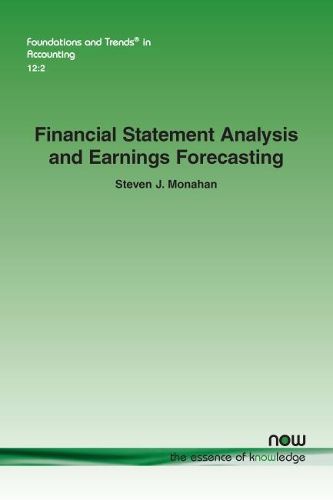Readings Newsletter
Become a Readings Member to make your shopping experience even easier.
Sign in or sign up for free!
You’re not far away from qualifying for FREE standard shipping within Australia
You’ve qualified for FREE standard shipping within Australia
The cart is loading…






This title is printed to order. This book may have been self-published. If so, we cannot guarantee the quality of the content. In the main most books will have gone through the editing process however some may not. We therefore suggest that you be aware of this before ordering this book. If in doubt check either the author or publisher’s details as we are unable to accept any returns unless they are faulty. Please contact us if you have any questions.
Financial Statement Analysis and Earnings Forecasting is the process of analyzing historical financial statement data for the purpose of developing forecasts of future earnings. This process is important because it is central to the valuation of companies and the securities they issue.
After a short introduction, Section 2 delves into the question Why earnings ? Focusing on dividend policy irrelevance, the author describes key analytical results that imply that expected earnings are the fundamental determinant of both equity and enterprise value. Section 3 examines the issues involved in selecting the earnings metric to forecast. Once an earnings metric has been chosen, the next question to ask is How useful are historical accounting numbers for developing forecasts of that metric? Sections 4 through 8 focus on this question. Section 4 discusses the general role of econometric modeling. Section 5 reviews time-series models. Section 6 examines the choices a researcher makes when using panel-data approaches and the author describes the advantages of these approaches. Section 7 reviews the role of accounting measurement in determining the usefulness of historical accounting numbers for developing forecasts of future earnings. Section 8 examines approaches for forecasting the higher moments of future earnings and section 9 provides a summary.
$9.00 standard shipping within Australia
FREE standard shipping within Australia for orders over $100.00
Express & International shipping calculated at checkout
This title is printed to order. This book may have been self-published. If so, we cannot guarantee the quality of the content. In the main most books will have gone through the editing process however some may not. We therefore suggest that you be aware of this before ordering this book. If in doubt check either the author or publisher’s details as we are unable to accept any returns unless they are faulty. Please contact us if you have any questions.
Financial Statement Analysis and Earnings Forecasting is the process of analyzing historical financial statement data for the purpose of developing forecasts of future earnings. This process is important because it is central to the valuation of companies and the securities they issue.
After a short introduction, Section 2 delves into the question Why earnings ? Focusing on dividend policy irrelevance, the author describes key analytical results that imply that expected earnings are the fundamental determinant of both equity and enterprise value. Section 3 examines the issues involved in selecting the earnings metric to forecast. Once an earnings metric has been chosen, the next question to ask is How useful are historical accounting numbers for developing forecasts of that metric? Sections 4 through 8 focus on this question. Section 4 discusses the general role of econometric modeling. Section 5 reviews time-series models. Section 6 examines the choices a researcher makes when using panel-data approaches and the author describes the advantages of these approaches. Section 7 reviews the role of accounting measurement in determining the usefulness of historical accounting numbers for developing forecasts of future earnings. Section 8 examines approaches for forecasting the higher moments of future earnings and section 9 provides a summary.